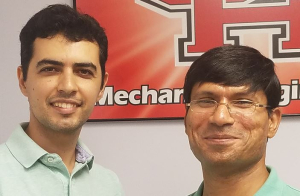Deep within your body there exists donut-shaped objects – many of them, in fact. No, these donuts aren’t from the box of Shipley’s that mysteriously disappeared, despite the fact your diet had just started. These particular donuts are the membranes of the nuclear envelope, which surround and protect the cell’s nucleus, where the all-important genetic material, or DNA, is stored. Why they are shaped like donuts has been one of biology’s great mysteries, but now a University of Houston Cullen College of Engineering professor may have found the recipe for one of the most fascinating structures inside a human cell.
In the Proceedings of National Academies of Science, Ashutosh Agrawal, assistant professor of mechanical engineering, explores the junk-food-shaped design in his article “Ultradonut topology of the nuclear envelope,” and concludes that mechanical forces play a critical role in shaping the nucleus, a finding that provides a fresh perspective into the design of the command centers of cells.
“The mechanics of the nucleus have not been explored much, even though the nucleus has our important genetic material,” said Agrawal. “This work should provide impetus to more biophysical studies to investigate the effect of forces on the workings of our nuclei. This is just the beginning of a less-explored area.”
Facing down your donut
The donut structure of the nuclear envelope is formed by two concentric membrane shells fused at numerous sites. Interestingly, not many scientists have delved into how the membranes achieve and keep such a unique shape.
Agrawal studied the donuts very carefully, investigating their geometry and the stability of the membranes in the presence of mechanical forces. He and his team, graduate student Mehdi Torbati and collaborator Tanmay Lele, engineering professor at the University of Florida in Gainesville, used nonlinear computer modeling to discover instabilities that lead to new sites for fusion between the layers.
They determined that buckling potentially occurs during the growth process, when the nucleus is growing and more membrane is being recruited. The recruitment of membrane can generate compressive forces that can destabilize membranes and set the stage for the formation of new pores (or holes).
“When a membrane buckles, it deforms to meet the other membrane, allowing the proteins to fuse them to create a new pore,” said Agrawal.
How many holes in your donut?
Topology of the nuclear envelope is defined by how many holes it has. Cell nuclei typically have a few thousand holes that are intriguingly present in a more or less uniform density. But why? Why don’t nuclei have 10 holes or a million holes for that matter, and why is the density fairly uniform?
Agrawal found that spacing larger than 500 nanometers (nm) basically does not exist because as the size of the membrane increases it becomes more unstable. “Once it reaches the 500 nm size, very small compression can buckle it – nuclear membrane becomes very unstable, and that’s why sizes beyond 500 nm will not be seen,” said Agrawal.
Now that Agrawal has discovered the impacts of mechanical forces and the reason for the observed topology, Lele will test these ideas in future experimental studies.
“He will do the experiments to test the impact of mechanical forces on the architecture of the membrane,” said Agrawal.
Agrawal compares his exploration of the nuclear envelope’s shape to the early stages of research done on red blood cells, before scientists understood why they were shaped like a concave disc.
“That had been a question that excited the scientific community for a long time, and now people can relate the shape of the red blood cell to its health.” said Agrawal.
One day he hopes that the doors he’s opened to the ultradonut-shaped world will swing wide with the answers to how all those donuts really affect our health.

